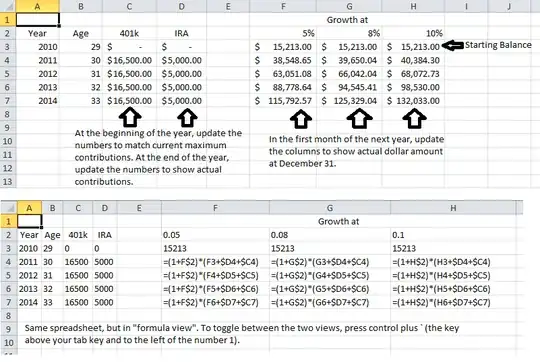How to save
I'm in my late twenties and am trying to get started off on the right foot saving for retirement. I have learned that retirement savings should usually be placed in retirement accounts in the following order:
- Roth 401(k) - Just enough to get the maximum company match. (if available)
- Roth IRA - Up to the annual max. ($5k per person for 2010/2011)
- Spouse's Roth IRA - Up to the annual max. ($5k per person for 2010/2011)
- Roth 401(k) - The rest of the way up to the annual max. ($16.5k per person for 2010)
(Please let me know if you disagree.) My understanding is that the 401(k) and IRA limits are independent, so I can put $5k into my Roth IRA, $5k into my wife's, $16.5k into my Roth 401(k), and $16.5k into my wife's Roth 401(k) if she had one. I can't imagine wanting to save more for retirement than that.
How to calculate "the number"
But that brings me to my real question: How much do I need to save for retirement? I have other financial goals like saving for a house down payment that need attention. So I tried to sit down and calculate "my number" ... how much money I will need to retire "comfortably." I'm pretty handy with a spreadsheet for this kind of stuff, but there are just so many factors that by the time I'm done with my calculation I'm not even sure if it's accurate.
So here is what I did. Please help me understand how I can tweak the calculation and/or where there is a good online tool.
My strategy was to first calculate how much money I would have at retirement if I contributed $5000 to a Roth IRA every year until retirement. I assumed a 10-11% average yield. Of course it varies greatly depending on how long I wait to retire. This is where the first problem comes in, because when I retire might depend on how much money is in my retirement accounts. That's no biggie because my spreadsheet lets me see the estimated balance for every year, so I can evaluate my options. The second problem so far is that I haven't factored for inflation: How will contribution limits rise? How much will my money be worth in today's dollars?
My next step was to calculate how long that money will last. For this I assumed an investment yield of 3-5%. (Lower yield since I will invest conservatively during retirement.) I gave myself a salary and subtracted the salary every year until all the money was gone. I also assumed a 3% inflation rate, so I gave myself a 3% raise every year.
Questions
So for example, if I start investing at 27, get a 10% yield, and retire at 65 I will have $2,116,952. Then if I get a 3% yield and give myself a 3% raise with a $70k starting salary, my money will last until I am 96. Not bad.
Based on this it sounds like if my wife and I max out our Roth IRAs and put enough into our 401(k)s to get the company match then we'll be more than fine. But what about inflation? Is $70k enough of a salary? (Of course it would be $140k if my wife did the same.)
Should I increase the annual contribution somehow? Should I use different estimated yields? Am I just way off?
